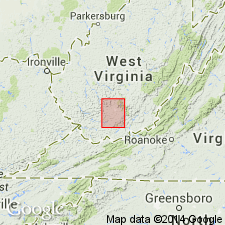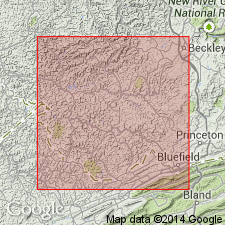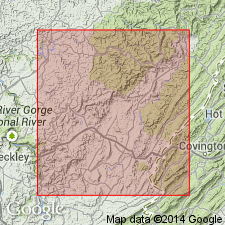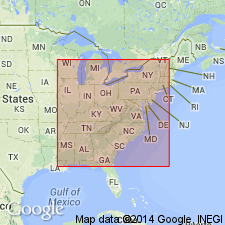
- Usage in publication:
-
- Guyandot sandstone* lentil
- Modifications:
-
- Named
- Dominant lithology:
-
- Sandstone
- Conglomerate
- AAPG geologic province:
-
- Appalachian basin
Summary:
Guyandot sandstone lentil of Sewell formation is described as a coarse, heavy-bedded sandstone or conglomerate, 0 to 100 ft thick, lying about 150 ft above base of Sewell formation and 80 to 100 ft below Harvey conglomerate lentil. Well exposed along Guyandot River from Pineville to Gilbert, southern WV. Age is Pennsylvanian.
Source: GNU records (USGS DDS-6; Reston GNULEX).

- Usage in publication:
-
- Guyandot sandstones
- Modifications:
-
- Revised
- AAPG geologic province:
-
- Appalachian basin
Summary:
Below the Guyandot sandstone is a persistent, massive to current-bedded, medium-grained, grayish white to light gray sandstone unit, 0 to 50 ft thick here referred to as the Lower Guyandot sandstone. Underlies Sewell A coal. Occurs 0 to 5 ft above Sewell ("Davy") coal, and lies 35+/-ft below the Guyandot sandstone. Forms steep slopes and cliffs.
Source: GNU records (USGS DDS-6; Reston GNULEX).

- Usage in publication:
-
- Guyandot sandstones
- Modifications:
-
- Revised
- AAPG geologic province:
-
- Appalachian basin
Summary:
In Greenbrier Co., the Guyandot sandstone of Campbell (1902) is massive, grayish white, and coarse grained. Unit is somewhat lenticular, in that it is replaced locally by sandy shale. Thickness ranges 30 to 50 ft. Underlies Castle coal; overlies Skelt shale. Locally apparently coalesces with stratigraphically higher Harvey sandstone. Lower Guyandot sandstone of Hennen and Gawthrop (1915) is massive coarse grained and grayish white in northern part of county. In Meadow Bluff district, its position in column is, in whole or in part, occupied by sandy shale. Thickness is 10 to 30 ft. Underlies Sewell "A" coal and overlies Hartridge shale. Both sandstones are included in the New River group (Pottsville Series).
Source: GNU records (USGS DDS-6; Reston GNULEX).

- Usage in publication:
-
- Guyandot sandstone
- Modifications:
-
- Overview
- AAPG geologic province:
-
- Appalachian basin
Summary:
Guyandot is a massive unranked sandstone cropping out on Laurel Fork of Guyandot River, 1 mi southwest of McGraw, Slab Fork district, Wyoming Co., WV. Occurs in upper part of New River Formation between Castle (above) and Sewell "B" coals.
Source: GNU records (USGS DDS-6; Reston GNULEX).
For more information, please contact Nancy Stamm, Geologic Names Committee Secretary.
Asterisk (*) indicates published by U.S. Geological Survey authors.
"No current usage" (†) implies that a name has been abandoned or has fallen into disuse. Former usage and, if known, replacement name given in parentheses ( ).
Slash (/) indicates name conflicts with nomenclatural guidelines (CSN, 1933; ACSN, 1961, 1970; NACSN, 1983, 2005, 2021). May be explained within brackets ([ ]).

